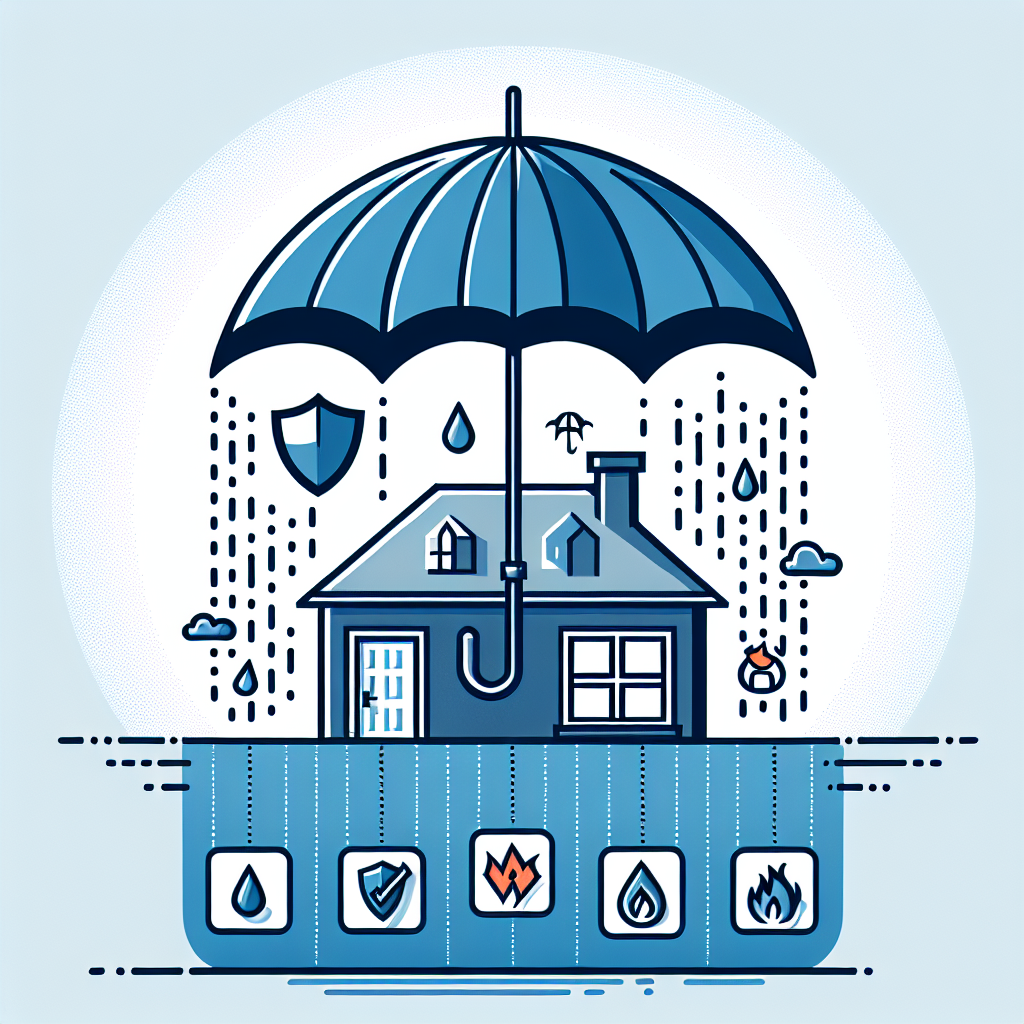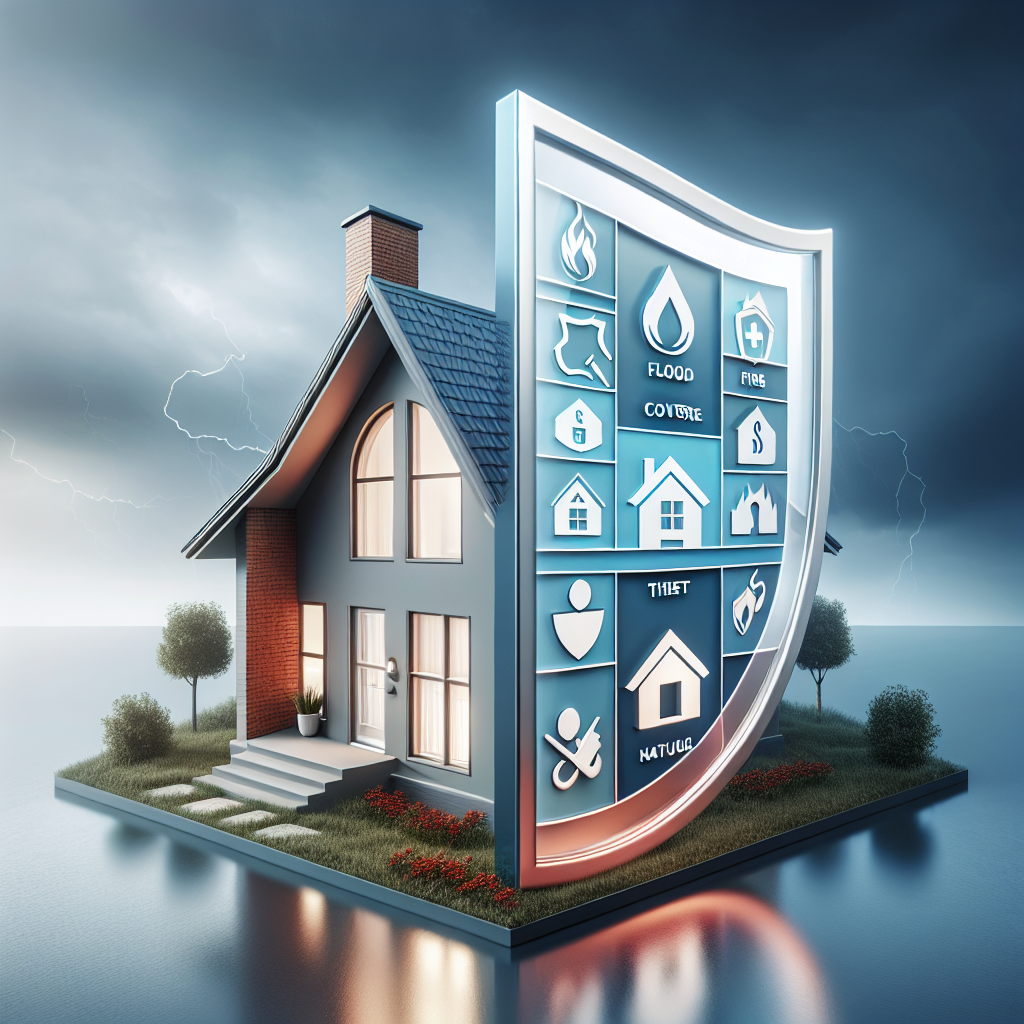Filed under Home Insurance on
Sewage Coverage Home Insurance Guide

When a sewer backs up into a home, the damage unfolds quickly: contaminated water wicks into walls, flooring delaminates, and irreplaceable belongings are ruined. Costs add up fast, and standard homeowners insurance does not automatically foot the bill for this kind of mess. If you want to protect your finances as well as your floors, you need to know exactly how sewage coverage works, where the gaps are, and which add-ons make sense for your property. Consider this your practical Sewage Coverage Home Insurance Guide, written to demystify policy language and give you step-by-step clarity.
What Counts as a Sewage Backup—and Why It Matters
Sewage backups occur when wastewater reverses direction and flows back into your home through drains, toilets, or floor cleanouts. The causes range from tree roots that choke old clay lines to overwhelmed municipal systems during cloudbursts. Even newer homes can see backups if sump pumps fail or a backwater valve sticks.
The stakes are high. Public health agencies classify sewage water as Category 3 (grossly contaminated) due to bacteria, viruses, and chemicals. Restoration isn’t a simple dry-out; it requires specialized cleaning, demolition of porous materials, and careful disposal. That complexity explains why a typical sewer backup can run into five figures, particularly if finished basements or HVAC systems are involved.
Several industry sources point to water damage as a top driver of home insurance claims, with severe weather and aging infrastructure magnifying losses. FEMA has long warned that even an inch of water can cause tens of thousands in damage—a sobering benchmark that applies squarely to sewage events.
Baseline Policy Reality: What Your Home Insurance Usually Does—and Does Not—Cover
Most standard homeowners policies (such as HO-3 or HO-5) exclude water that backs up through sewers or drains unless you add a specific endorsement. Without that add-on, any cleanup and repairs may be out of pocket—even if the event wasn’t your fault. This is why so many homeowners seek a clear Sewage Coverage Home Insurance Guide before renewing or switching carriers.
Commonly Covered With the Right Add-On
- Professional cleanup and sanitization for Category 3 water
- Removal and replacement of contaminated building materials and finishes
- Repairs to damaged fixtures and systems inside the home
- Replacement of personal property ruined by sewage (subject to policy terms)
- Additional living expenses if the home is uninhabitable during repairs
Often Excluded or Limited
- Repair or replacement of the damaged sewer lateral itself (unless you add service line coverage)
- Losses caused by wear and tear, neglected maintenance, or gradual seepage
- Groundwater intrusion or flooding from surface water (different coverage altogether)
- Damage outside the insured premises unless your endorsement extends offsite
Understanding which policy provisions apply in your case is crucial. Insurers distinguish among sudden and accidental water damage, sewer or drain backup, and flood. Each has different triggers, exclusions, and solutions, which this Sewage Coverage Home Insurance Guide breaks down below.
Two Core Add-Ons That Protect You From Sewage Losses
Water Backup and Sump Overflow Endorsement
This endorsement is the backbone of sewage protection for most homeowners. It applies when water or sewage backs up through sewers, drains, or sump pumps. Coverage limits often start around $5,000 and can be raised to $25,000, $50,000, or more depending on the carrier and your home’s risk profile. The endorsement typically covers cleanup, damaged finishes, and affected personal property. In many policies, it also extends to sump pump overflow due to mechanical failure or power outage, though details vary.
Premium impact is usually modest compared with a potential claim. Many homeowners pay roughly $50 to $250 per year for this endorsement, influenced by location, claims history, and the limits you select. Deductibles can be separate or tied to the main policy; clarify this before you bind coverage.
Service Line Coverage (Including Sewer Lateral)
Service line endorsements cover buried utility lines on your property, including the sewer lateral running from your home to the municipal connection or septic tank. Covered causes may include wear and tear, rust, tree root intrusion, collapse, or freeze. This coverage helps pay for excavation, line repair or replacement, landscaping restoration, and sometimes loss of use if your home becomes uninhabitable.
Service line coverage limits often range from $10,000 to $20,000, with optional increases. Annual cost is typically in the ballpark of $20 to $80, depending on your insurer and selected limit. Paired with a water backup endorsement, it fills a major gap: the line itself, which is often excluded under standard policies.
Flood Insurance vs. Sewage Backup: Know the Difference
Flood insurance, typically obtained through the National Flood Insurance Program or private insurers, applies to inundation from overland water—rising rivers, storm surge, or surface runoff affecting two or more properties or two or more acres. If sewage backs up specifically due to a flood event, the flood policy may respond, but a standard homeowners policy will not unless the backup is otherwise covered. Many families carry both flood insurance and water backup endorsements because the triggers are distinct and complementary.
How Much Coverage Should You Buy?
Determining the right limit is part math, part risk tolerance. Use this framework:
- Inventory at-risk areas: If you have a finished basement, list flooring, drywall, built-ins, appliances, electronics, and stored items.
- Estimate labor and materials: Restoration for Category 3 water includes demolition, disposal, sanitizing, drying, and reconstruction. Consider local labor rates.
- Account for personal property: High-value rugs, furniture, and electronics add up quickly. Replacement cost coverage is preferable to actual cash value.
- Add contingency: Many families choose limits of $10,000 to $25,000; finished basements or high-end finishes may justify $50,000 or more.
- Layer protection: Combine water backup with service line coverage to address both interior damage and the buried pipe itself.
The incremental premium to increase limits is often small relative to the potential payout. As emphasized throughout this Sewage Coverage Home Insurance Guide, limit decisions should reflect the true replacement cost of your space and contents—not just a round number that sounds safe.
What a Typical Claim Looks Like
- Safety and mitigation: Shut off affected circuits, avoid contact with contaminated water, and stop the source if possible.
- Documentation: Photograph every room, every angle, and each damaged item before cleanup. Keep receipts.
- Call your insurer: Report the loss promptly and confirm whether your water backup endorsement is active and what sublimits apply.
- Professional remediation: Use certified water damage and biohazard contractors. Insurers often maintain vetted vendor networks.
- Scope and estimate: An adjuster or independent appraiser verifies damage. You’ll receive an estimate aligning with policy terms.
- Repairs and contents: Keep an itemized record of all replaced materials and belongings. Save samples of flooring and drywall when requested.
- Payment and close: Insurers may issue multiple payments—initial ACV, then recoverable depreciation once work is completed (if replacement cost applies).
Common Claim Mistakes to Avoid
- Delaying mitigation, which can worsen contamination and trigger mold exclusions
- Throwing away damaged items before documenting them thoroughly
- Using non-specialist contractors unequipped for Category 3 remediation
- Assuming the city will pay if a public main backed up—third-party recovery is often slow and uncertain
- Overlooking code upgrades; ask if Ordinance or Law coverage applies to bring repairs up to current code
Prevention Pays: Reduce Your Risk Before a Storm Hits
Home Improvements With Outsized Impact
- Install a backwater valve on the main drain line to block reverse flow from the street
- Maintain or upgrade your sump pump; add a battery or water-powered backup
- Replace aging sewer laterals (clay or cast iron) with PVC; add a cleanout access if missing
- Use floor drain plugs or standpipes in basements prone to backups
- Add water sensors near floor drains, washers, water heaters, and sump pits for early alerts
- Trim or remove deep-rooted trees near the sewer line; consider root barriers
Maintenance and Everyday Habits
- Never flush wipes (even “flushable”), diapers, or feminine products
- Collect cooking grease in containers for disposal; don’t pour it down the drain
- Schedule periodic camera inspections of older lines to catch root intrusion or collapse early
- Redirect downspouts 5 to 10 feet away from your foundation to reduce hydrostatic pressure
- Verify that washing machine and water softener discharges are plumbed correctly
Storm Readiness Checklist
- Test sump pump operation and backup power before heavy rain
- Move valuables and electronics off basement floors and onto shelves
- Close backwater valve flappers and confirm free movement
- Keep a wet/dry vacuum, contractor bags, and protective gear on hand for initial triage
Different Homes, Different Rules
Single-Family Homes
Ownership runs from the foundation to the street-side connection in many municipalities, meaning the homeowner is responsible for the lateral. Pairing water backup and service line coverage is the gold standard for comprehensive protection.
Landlords and Renters
Landlords can face not only property damage but also loss of rental income if tenants must vacate. Confirm that your policy includes loss of rents and that water backup applies to multi-unit exposures. Renters should ask for a water backup endorsement on their renters policy to cover personal property and additional living expenses.
Condos and HOAs
Condominium master policies may cover some building components, but responsibility for interior surfaces and fixtures often falls to the unit owner. An HO-6 policy with water backup and loss assessment coverage helps cover gaps when the association’s deductible or exclusions leave unit owners exposed. Review bylaws and master policy forms carefully.
Trends Raising the Stakes
Several macro forces are reshaping the risk landscape:
- Heavier, more frequent downpours stress municipal systems and older neighborhoods
- Aging infrastructure increases the odds of blockages and main line surcharges
- Finished basements and home gyms concentrate more value below grade than ever
- Insurers are refining underwriting, requiring higher deductibles or sublimits in some areas
The takeaway is not alarmism but readiness. Carrier appetite and pricing will evolve with loss data, so annually reviewing your protections—especially the endorsements highlighted in this Sewage Coverage Home Insurance Guide—keeps your coverage aligned with real-world exposure.
How to Shop Smart and Compare Quotes
- Confirm definitions: How does the policy define “water backup” and “sump overflow” triggers?
- Check sublimits: Are there separate caps for building, contents, and additional living expenses?
- Ask about service line: What causes of loss are covered for the sewer lateral? Are root intrusion and collapse included?
- Deductible structure: Is there a separate deductible for water backup or a higher All Peril deductible?
- Exclusions to flag: Groundwater seepage, repeated leakage, or “maintenance-related” exclusions can reduce payouts.
- Upgrade options: Can you raise limits to $25,000, $50,000, or higher? What’s the cost per additional $5,000?
- Vendor networks: Does the insurer offer 24/7 access to certified remediation firms with guaranteed response times?
- Loss history impact: How do prior water claims affect eligibility and pricing for endorsements?
- Discounts for mitigation: Are there premium credits for backwater valves, sump backups, or line replacement?
Request quotes that mirror each other in limit, deductible, and endorsements to make apples-to-apples comparisons. An independent agent can pull options from multiple carriers and highlight differences hidden in policy forms.
Real-World Scenarios and Payout Patterns
- Tree root intrusion in a 1970s clay lateral leads to a backup that ruins carpet, baseboards, and furniture in a finished basement. Water backup endorsement pays for cleanup and interior restoration, while service line coverage funds excavation and pipe replacement, including lawn restoration.
- A violent thunderstorm triggers a brief power outage and sump pump failure, sending water and sewage through a basement floor drain. The homeowner’s policy includes water backup with a $25,000 limit and a separate $500 deductible, covering remediation and reconstruction.
- Condo stack backup from an upper floor affects two units. The association’s master policy addresses common elements, but unit owners rely on HO-6 water backup endorsements for interior finishes and personal property. Loss assessment coverage helps with the HOA’s high deductible.
What Experts and Data Suggest
Risk engineers and building scientists consistently recommend backwater valves and proactive line maintenance as first-line defenses, particularly in older urban areas. Industry associations emphasize that fast, professional remediation reduces both health risks and claim severity. The Insurance Information Institute and similar organizations note that water-related claims are among the most frequent and costly, especially as weather patterns intensify and basements contain more high-value contents.
Public agencies underscore that municipal liability may be limited—even when a city main surcharges into private homes. That reality reinforces why the endorsements in this Sewage Coverage Home Insurance Guide are not luxuries but pragmatic safeguards.
Frequently Asked Questions
Is sewage backup the same as a flood?
No. A flood involves overland water affecting multiple properties or a large area. Sewer or drain backup is a different peril with its own endorsement under homeowners insurance.
Will my insurer pay to replace the sewer line?
Not under a standard policy. Service line coverage is the add-on that typically pays for buried line repairs on your property, including root damage and collapse, subject to policy terms.
Are tree roots considered maintenance?
Many policies exclude wear and tear or maintenance, but service line endorsements often specifically cover root intrusion. Read the endorsement’s covered causes of loss section carefully.
Does renters insurance cover sewage backup?
Renters can add a water backup endorsement to cover personal property and additional living expenses. The landlord’s policy covers structural repairs, but not a tenant’s belongings.
What if the city is at fault?
You can file a claim with the municipality, but recovery is uncertain and slow. Your own policy’s backup endorsement is the fastest route to restoration. Subrogation may allow your insurer to pursue reimbursement later.
Are septic systems included?
Some water backup endorsements address septic and sump overflows, while service line coverage may extend to private septic lines. Confirm scope with your insurer.
Will my premium increase after a backup claim?
Possibly. Water losses can affect rates and eligibility for endorsements. Mitigation upgrades and a claim-free period can help stabilize future pricing.
Can I add coverage after a loss?
Insurance is designed for future, not immediate, needs. Carriers generally won’t backdate endorsements. Add coverage before you need it.
Is mold from a sewage backup covered?
Many policies limit mold coverage. Immediate professional remediation reduces the chance of mold and strengthens your claim under water backup terms.
Glossary of Key Terms
- Water Backup Endorsement: An add-on that covers damage from water or sewage backing up through sewers, drains, or sump overflows.
- Service Line Coverage: An endorsement covering repair or replacement of buried utility lines on your property, including the sewer lateral.
- Backwater Valve: A device installed in the main drain line to prevent reverse flow from municipal sewers into a home.
- Category 3 Water: Heavily contaminated water requiring specialized cleanup and disposal procedures.
- Additional Living Expenses (ALE): Coverage for temporary housing and related costs when a home is uninhabitable due to a covered loss.
- Ordinance or Law Coverage: Pays for additional costs to bring repairs up to current building codes.
Action Plan: A Five-Step Checklist
- Review your declarations page: Confirm whether you carry a water backup endorsement and at what limit.
- Add service line coverage: Close the gap on lateral repairs and excavation.
- Right-size limits: Align coverage with the true cost to restore your basement and replace contents.
- Mitigate: Install a backwater valve, sump pump backup, and water sensors; schedule a camera inspection if your line is older.
- Document and update: Photograph your basement and stored items; revisit coverage annually or after renovations.
Building this checklist into your annual insurance review gives you a repeatable process for staying ahead of risk. If you take nothing else from this Sewage Coverage Home Insurance Guide, let it be that endorsements and mitigation together deliver the strongest defense.
Final Takeaways
Sewage backups are messy, expensive, and increasingly common in communities with aging infrastructure and heavier downpours. Standard homeowners insurance rarely covers them without endorsements. Combining a water backup endorsement with service line coverage creates a comprehensive safety net for both the interior damage and the buried pipe that often causes trouble.
Work with an experienced agent to compare definitions, sublimits, and deductibles across carriers. Invest in prevention—backwater valves, sump backups, and regular line inspections—because risk reduction can save you thousands and expedite claims. Above all, act before the next storm rolls in. A small premium now can prevent a budget-breaking emergency later.
Use this Sewage Coverage Home Insurance Guide as your blueprint for confident decisions, better coverage, and a home that’s ready for whatever your drains and the weather send your way. When you revisit your policy each year, return to this Sewage Coverage Home Insurance Guide and walk through the checklist. If you are advising a friend or neighbor, share the essentials from this Sewage Coverage Home Insurance Guide so they can build protection too. With the right steps, this Sewage Coverage Home Insurance Guide becomes more than reading material—it becomes a plan.





